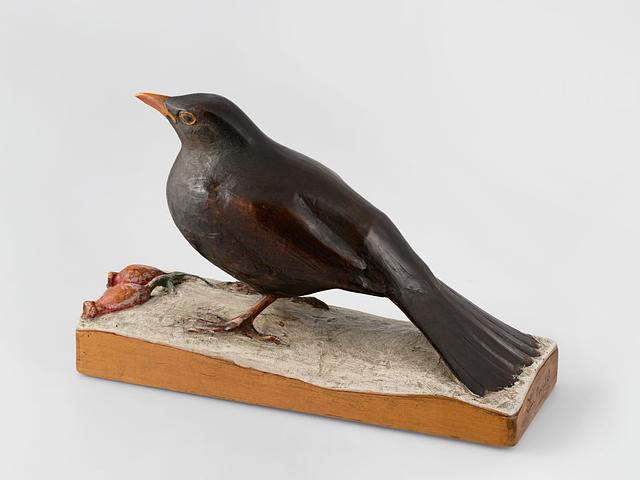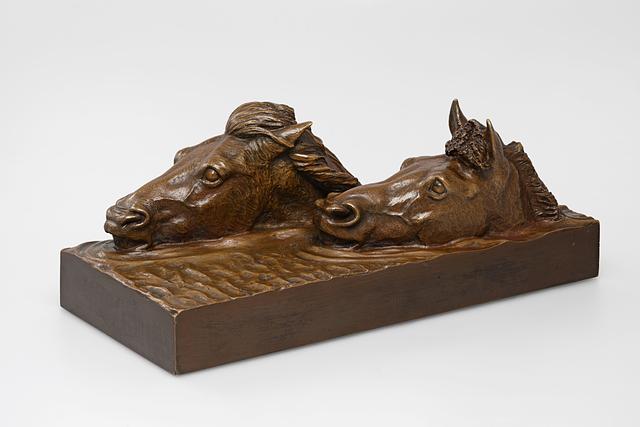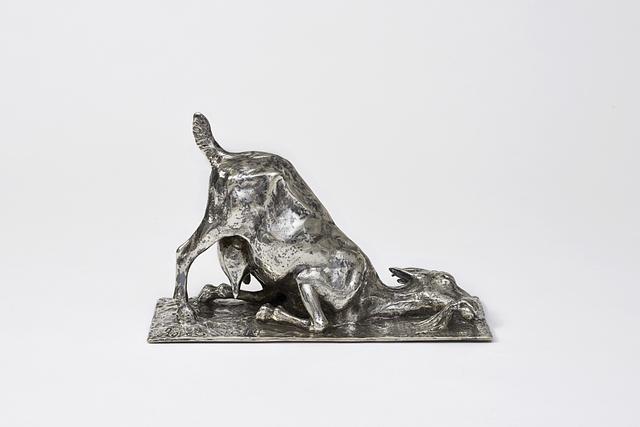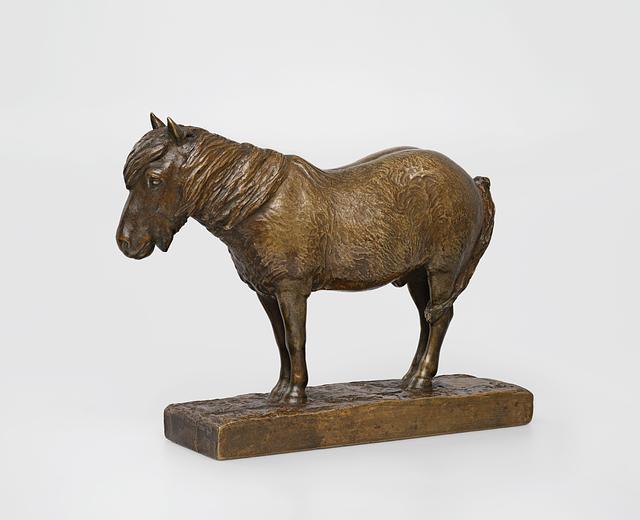Jean René Gauguin (1881–1961)
Man Dancing, 1915/1918
Silver
H: 22.7 cm
Inventory number B 296
Jean René Gauguin was a trained carpenter, but his wanderlust, inquisitive mind and great interest in sculpture set him on a different path. In 1911, the then 30-year-old artist made his debut at Den Frie Udstilling, presenting a number of figures and coloured reliefs in wood. His artistic breakthrough came a few years later – in 1915 – at the first exhibition presented by the Danish artists’ cooperative Grønningen. Here, Gauguin exhibited a collection of statuettes which were unusual, if not downright peculiar for the time, depicting subjects such as centaurs, jockeys and grotesque dancing figures, including a bronze cast of Man Dancing.
The long-limbed figure eloquently embodies how Gauguin, even at an early point in his career, had a unique knack for depicting figures in motion. Man Dancing is depicted in a state of highly energetic movement. One leg is raised high, as are the arms, one of which almost seems to be out of joint. Added to this, the elongated head and the distorted face with the open mouth create an impression verging on the grotesque.
Throughout his long artistic career, Gauguin evinced a desire to experiment with many different materials. He initially worked mainly with wood and bronze, but gradually devoted himself to the soft, malleable clay. In 1923, he began working at the porcelain factory Bing & Grøndahl – first on temporary assignments, then as a tenured artist who mainly focused on unique pieces. He used clay to craft figure groups, animals and mythical creatures that twist, turn, meander and stretch out in extreme poses, as exemplified by one of his main works, Merman and Mermaid from 1928.1
The statuette found in The David Collection was cast in silver in 1918, when Gauguin had his first solo show at Dansk Kunsthandel – a gallery in Copenhagen at the behest of the art collector Johannes Rump in 1917. Gauguin was one of the few artists who were permanently associated with Dansk Kunsthandel until its formal dissolution in 1932.2 Exactly when C.L. David acquired Man Dancing is unknown.
The long-limbed figure eloquently embodies how Gauguin, even at an early point in his career, had a unique knack for depicting figures in motion. Man Dancing is depicted in a state of highly energetic movement. One leg is raised high, as are the arms, one of which almost seems to be out of joint. Added to this, the elongated head and the distorted face with the open mouth create an impression verging on the grotesque.
Throughout his long artistic career, Gauguin evinced a desire to experiment with many different materials. He initially worked mainly with wood and bronze, but gradually devoted himself to the soft, malleable clay. In 1923, he began working at the porcelain factory Bing & Grøndahl – first on temporary assignments, then as a tenured artist who mainly focused on unique pieces. He used clay to craft figure groups, animals and mythical creatures that twist, turn, meander and stretch out in extreme poses, as exemplified by one of his main works, Merman and Mermaid from 1928.1
The statuette found in The David Collection was cast in silver in 1918, when Gauguin had his first solo show at Dansk Kunsthandel – a gallery in Copenhagen at the behest of the art collector Johannes Rump in 1917. Gauguin was one of the few artists who were permanently associated with Dansk Kunsthandel until its formal dissolution in 1932.2 Exactly when C.L. David acquired Man Dancing is unknown.
Published in
Published in
Asger E. Bremer: Jean René Gauguin og hans arbejder, København 1941, fig. 1, p. 87;
Lars Dybdahl in Kjeld von Folsach and Nana Lund (eds.): Dansk kunst i Davids Samling – fra Philipsen til Saxbo, Davids Samling, København 1995, cat.no. 65, pp. 158-159;
Lars Dybdahl: Dansk design 1910-1945: art déco & funktionalisme, Kunstindustrimuseet, København 1997, cat.no. E104;
Teresa Nielsen and Gunnar Jacobsen: Jean René Gauguin, Vejen Kunstmuseum, Vejen 2002, p. 22. (Version from 1915 in bronze);
Ole Nørlyng: ”At danse selve livet. Dansens betydning og former i vitalismens spejl” in Gertrud Oelsner and Gertrud Hvidberg-Hansen (eds.): Livslyst. Sundhed, skønhed, styrke i dansk kunst 1890-1940, Fyns Kunstmuseum, Odense Bys Museer and Fuglsang Kunstmuseum, Toreby 2008, fig. 190, p. 266;
Marie Oxholm Zigler (ed.): Cool Moderne: Art Deco i dansk billedkunst 1910-40, Gl. Holtegaard, Holte 2015, cat.no. 38, pp. 19, 60;
Lars Dybdahl in Kjeld von Folsach and Nana Lund (eds.): Dansk kunst i Davids Samling – fra Philipsen til Saxbo, Davids Samling, København 1995, cat.no. 65, pp. 158-159;
Lars Dybdahl: Dansk design 1910-1945: art déco & funktionalisme, Kunstindustrimuseet, København 1997, cat.no. E104;
Teresa Nielsen and Gunnar Jacobsen: Jean René Gauguin, Vejen Kunstmuseum, Vejen 2002, p. 22. (Version from 1915 in bronze);
Ole Nørlyng: ”At danse selve livet. Dansens betydning og former i vitalismens spejl” in Gertrud Oelsner and Gertrud Hvidberg-Hansen (eds.): Livslyst. Sundhed, skønhed, styrke i dansk kunst 1890-1940, Fyns Kunstmuseum, Odense Bys Museer and Fuglsang Kunstmuseum, Toreby 2008, fig. 190, p. 266;
Marie Oxholm Zigler (ed.): Cool Moderne: Art Deco i dansk billedkunst 1910-40, Gl. Holtegaard, Holte 2015, cat.no. 38, pp. 19, 60;
Footnotes
Footnotes
1.
Joachim Meyer: ‘Johannes Rump som kunsthandler – historien om Dansk Kunsthandel (1917-19)’ in Lennart Gottlieb (ed.): Portræt af en samler, Statens Museum for Kunst, Copenhagen 1994, p. 50.
2.
Jean René Gauguin, Mermain and Mermaid fountain, 1928, Ordrupgaard.
.jpg)
.jpg)
.jpg)



